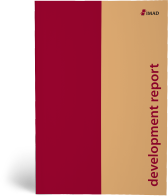Financial markets and prices
The financial crisis revealed a number of structural imbalances in the banking and corporate sectors. The beginning of the stabilisation and privatisation of banks was the first step in restructuring these sectors. In recent years, the financial system has operated in a context of a very expansionary monetary policy that has kept pace with the challenges of the economy. Central banks have responded to rising inflation by accelerating the normalisation of monetary policy, which poses an additional challenge to both economic activity and the maintenance of financial stability.
Development Report 2017
Following the setback during the crisis, Slovenia has been making progress in terms of economic development and the welfare of its population in recent years; it has also reduced pressures on the environment. Since 2014 the economic picture has been improving, and Slovenia is again catching up with economically more advanced countries. The recovery has led to an overall improvement in the material…
Development Report 2016
In the past few years, Slovenia has taken a number of positive steps and slightly narrowed its development gap with the EU. Regardless of positive shifts, challenges remain in terms of ensuring a more sustainable improvement to Slovenia’s growth potential and the welfare of its population, which will require more radical structural changes.
Slovenian Economic Mirror 3/2016
GDP growth in the euro area continued at the beginning of the year. Activity increased further in most sectors in Slovenia at the beginning of the year. The labour market situation continues to improve. Owing to good business performance, average gross earnings per employee in the private sector rose significantly in the last four months. Export competitiveness improved further.
Development Report 2016
In the past few years, Slovenia has taken a number of positive steps and slightly narrowed its development gap with the EU. Regardless of these positive shifts, challenges remain in terms of ensuring a more sustainable improvement to Slovenia’s growth potential and the welfare of its population, which will require more radical structural changes.
Slovenian Economic Mirror 2/2016
At the beginning of the year, short-term indicators of economic activity in the euro area continued to improve; the values of confidence indicators remained relatively high despite deterioration. In Slovenia, most short-term indicators of economic activity improved further at the beginning of the year.
Slovenian Economic Mirror 1/2016
The EC and IMF predict a continuation of economic growth in Slovenia’s main trading partners in 2016, but point to increased risks particularly with regard to developments in emerging economies. Most short-term indicators of economic activity in Slovenia remained at the achieved levels towards the end of 2015. Towards the end of the year, the number of employed persons continued to grow; in…
Development Report 2015
The year 2014 was marked by positive shifts in terms of economic development, the deterioration in the material position of households was halted, while pressures on the environment eased during the crisis, mainly under the influence of weak economic activity. To ensure more permanent economic growth and sustainable convergence to more developed countries, and to maintain the quality of life and…

